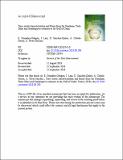Por favor, use este identificador para citar o enlazar a este item:
http://hdl.handle.net/10261/200644COMPARTIR / EXPORTAR:
 SHARE SHARE
 CORE
BASE CORE
BASE
|
|
| Visualizar otros formatos: MARC | Dublin Core | RDF | ORE | MODS | METS | DIDL | DATACITE | |

| Título: | Trace metal characterization and fluxes from the Guadiana, Tinto-Odiel and Guadalquivir estuaries to the Gulf of Cadiz |
Autor: | González-Ortegón, Enrique CSIC ORCID ; Laiz, Irene CSIC; Sánchez-Quiles, David CSIC ORCID ; Cobelo-García, A. CSIC ORCID; Tovar-Sánchez, Antonio CSIC ORCID | Palabras clave: | Riverine inputs Biogeochemical cycles Metal Gibraltar Strait Pollution Land uses |
Fecha de publicación: | 2019 | Editor: | Elsevier | Citación: | Science of the Total Environment 650(2): 2454-2466 (2019) | Resumen: | Metals transported into the coastal zone by the South Iberian rivers are key to understand the biogeochemical cycles and distribution of trace elements in the Gulf of Cadiz (GoC hereinafter) and the exchange with the Mediterranean Sea. Previous studies carried out in the 80s have suggested that metal enrichment in the Alboran Sea (Western Mediterranean) is related with fluvial inputs from acid mine drainage from the Tinto and Odiel rivers. The present study evaluates the contribution of dissolved trace metal concentrations (i.e. Cd, Co, Cu, Fe, Mo, Ni, Pb, V, Zn) from the three main rivers discharging into the GoC (i.e. Guadiana, Tinto-Odiel and Guadalquivir rivers). Our results show that the metal composition of water discharged from each river is impacted by the activities developed in the course of the rivers, which clearly influence the GoC coastal surface waters composition. Metal fluxes from the Guadalquivir river are quantitatively higher than those from the Tinto-Odiel (e.g. up to 73% and 19% higher for Ni and Cu, respectively). Although the metal concentrations spatial distributions in the GoC are dominated by the circulation pattern between the Atlantic and the Mediterranean Sea, the concentrations within the GoC continental shelf could be explained by a greater contribution from the Guadalquivir estuary (e.g. 80.5%, 54.6%, 56.5% and 56.6% for Ni, Cu, Mo, and V respectively) | Descripción: | 13 pages, 6 figures, 2 tables | Versión del editor: | https://doi.org/10.1016/j.scitotenv.2018.09.290 | URI: | http://hdl.handle.net/10261/200644 | DOI: | 10.1016/j.scitotenv.2018.09.290 | ISSN: | 0048-9697 | E-ISSN: | 1879-1026 |
| Aparece en las colecciones: | (IIM) Artículos (ICMAN) Artículos |
Ficheros en este ítem:
| Fichero | Descripción | Tamaño | Formato | |
|---|---|---|---|---|
| Trace_metal_characterization_2019.pdf | 14,43 MB | Adobe PDF |  Visualizar/Abrir |
CORE Recommender
SCOPUSTM
Citations
33
checked on 18-abr-2024
WEB OF SCIENCETM
Citations
31
checked on 27-feb-2024
Page view(s)
176
checked on 19-abr-2024
Download(s)
178
checked on 19-abr-2024
Google ScholarTM
Check
Altmetric
Altmetric
NOTA: Los ítems de Digital.CSIC están protegidos por copyright, con todos los derechos reservados, a menos que se indique lo contrario.
